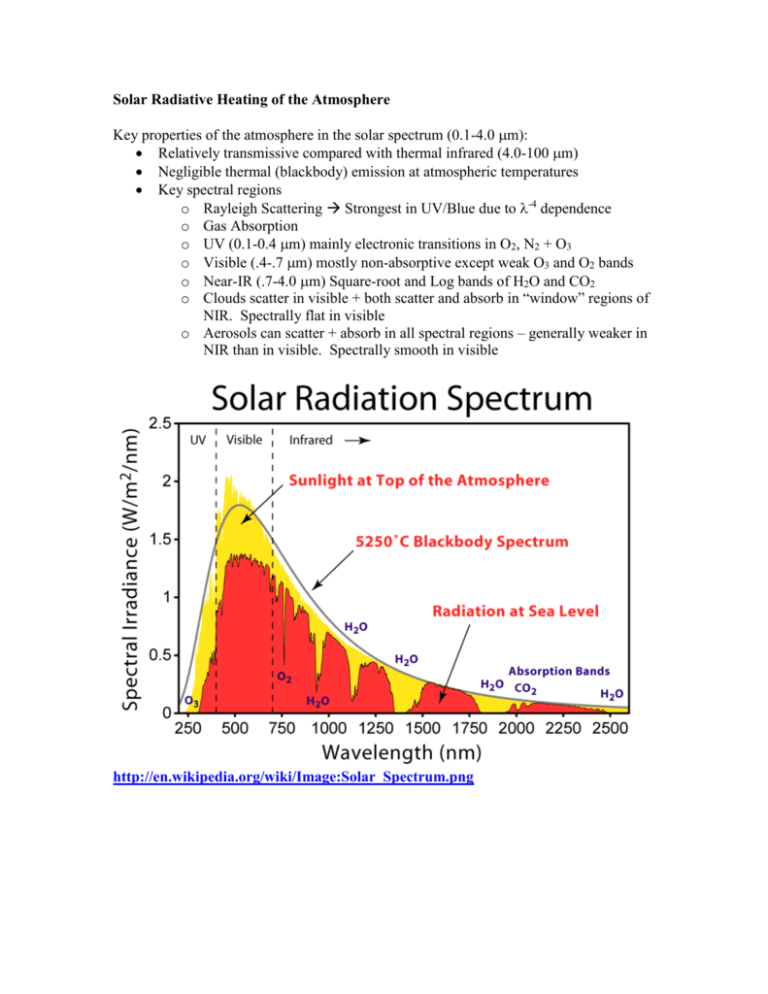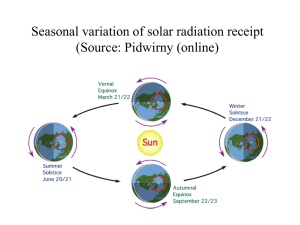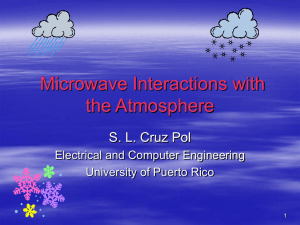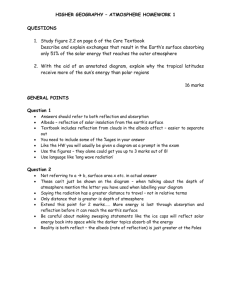L27
advertisement

Solar Radiative Heating of the Atmosphere Key properties of the atmosphere in the solar spectrum (0.1-4.0 m): Relatively transmissive compared with thermal infrared (4.0-100 m) Negligible thermal (blackbody) emission at atmospheric temperatures Key spectral regions o Rayleigh Scattering Strongest in UV/Blue due to -4 dependence o Gas Absorption o UV (0.1-0.4 m) mainly electronic transitions in O2, N2 + O3 o Visible (.4-.7 m) mostly non-absorptive except weak O3 and O2 bands o Near-IR (.7-4.0 m) Square-root and Log bands of H2O and CO2 o Clouds scatter in visible + both scatter and absorb in “window” regions of NIR. Spectrally flat in visible o Aerosols can scatter + absorb in all spectral regions – generally weaker in NIR than in visible. Spectrally smooth in visible http://en.wikipedia.org/wiki/Image:Solar_Spectrum.png Kiehl and Trenberth, 1997 The net result is that ~50% of sunlight is absorbed by the surface, mostly in the visible portion of the spectrum. The atmospheric absorption amounts to about 67 W m-2, averaged over the surface of the planet, out of a TOA incident solar amount of 342 W m-2. Of this, 38 Wm-2 is caused by NIR water vapor absorption, 15 Wm-2 is by O3 in the visible and ultraviolet, 12 Wm-2 is by clouds, and 2 Wm-2 is by O2 in the visible and UV. Were clouds removed, the absorption by water vapor would actually go up, since cloud absorption and reflection shield the low-lying water vapor, on average. So the net effect of clouds is only 7 W m-2. Stratospheric absorption: The key absorbers are highly variable in space, and thus the absorption is not uniform. Likewise, pressure broadening and band-transmission factors highly modify the vertical absorption patterns. There are some spectral regions that absorb significantly, where other regions do not. For example, very short wavelengths of solar radiation are entirely absorbed in the uppermost regions of the atmosphere due to the large cross-sections of virtually all the molecules there, such as the reaction O2 + h 2O. This photochemical reaction leads to O + O2 + M O3 + M. O3 wouldn’t exist in the stratosphere if it weren’t for the very high energy photons < 250 nm. Ozone is present in very high concentrations in the stratosphere, but not in the troposphere largely because 240 nm light doesn’t make it through the upper stratosphere, killing the primary precursor to O3. Once ozone is created, however, it does a good job of absorbing radiation below 320 nm. (O3 + h O2 + O). As a consequence, very little of radiation in this region makes it below the tropopause. Due to the strong absorptivity of the stratosphere to the shortest wavelengths of solar radiation, we have a situation – for the upper atmosphere alone – that <> > <>. That is, if you take the average the absorptivity of the stratosphere weighted by the spectrum of solar radiation incident at these levels, and then compare this to the absorptivity (=emissivity) weighted over the Planck function at these altitudes, you end up with the result that there is greater absorptivity in the solar than emissivity in the IR. The low emissivity is partly because of the lack of water vapor in the stratosphere, and partly due to the weak pressure broadening, which enhances absorption by saturated lines. As a result, the upper stratospheric temperatures exceed 255K, which is the temperature of emission from below. This was one of the key results of the greenhouse effect calculations – you get a negative greenhouse effect if the downward transmissivity is less than the upward transmissivity of a layer. Calculation of vertical heating rate We can explore this with the calculation of vertical heating rate seen in the text (p. 131). First consider only the solar heating rate due to one narrow wavelength region. We start with Beer’s law, which says dI I d where d = akds This means that an amount of energy equal to dIndAdd, where (d is the solid angle, dA is the cross-sectional area of our path) is absorbed in the volume dAds. Since this absorbed energy leads to heating, we have dq = CdT, where dq is the radiative heat absorbed, and C is the heat capacity of our volume (J/K). Thus we have contribution to heating due to absorption of radiation from a single wavelength and direction being, (cpdAds) (dT/dt)|, = IakdsdAdd. Noting that the volumes appear on both sides of this equation, we end up with cp(dT/dt) |, = Irakdd. where ra = (a/) is the mass-mixing ratio of the absorber. The above expression applies only to intensity from one direction and at one wavelength. Integrating over the entire radiation field, we have cp dT ra I k dd dt 0 4 Note that this expression is insensitive to the direction the radiation is coming from. The increased path length through a layer of the atmosphere is cancelled by the increased volume the path subtends through the layer. That increased volume is responsible for the increased rate of extinction with altitude, z, or vertical optical depth, . Let's assume we have some gas that is well mixed in the atmosphere (i.e. ra is constant), and has an absorption band where k = constant within that band of width , and is zero elsewhere. Since the band-average properties are constant and all the radiation is coming from a narrow range of angles, we can treat the band using Beer’s law. Also, it is more convenient to deal with the downward flux, instead of the flux normal to the direction of propagation. Thus we have S = <I> dS S d S = S0exp(-/) It is useful at this point to consider things back in vertical coordinates of distance, or pressure. We now have d = -akdz p 1 k ra dp g0 If the mixing ratio and mass absorption cross-section are invariant with height, then we have k r S S 0 exp a p g The flux divergence, dS/dz is equal to the rate of absorption by the layer, per unit volume, Qa Q = -(dS/dz) = -S (kra/g)(dp/dz) = -S kra/ We have that dQ ~ exp(-c), which is a function that peaks at an optimum altitude. For strongly absorbing bands, this altitude is high in the atmosphere, as most of the absorption occurs when the radiation first penetrates that atmosphere. As the absorption becomes weaker, the distribution of absorption passes to lower and lower regions of that atmosphere. as s (the surface optical depth of the band) ~ 1, some of the radiation penetrates to the surface, allowing the total atmospheric absorption to fall off like 1-exp(-s). For very weak absorption bands, we go back to the linear limit, where total atmospheric absorption ~s. This behavior explains the strong upper atmosphere heating in the UV. The lower atmosphere has the same absorptivity as the upper atmosphere, but the radiation field is depleted. This result also has implications for the vertical distribution of water vapor absorption in the NIR. Remember, that there are several vibration absorption bands with saturated line centers, and weakly-overlapping and strongly-overlapping wings. Thus as we examine k for the NIR spectrum of water vapor we see there is a wide distribution of values as a function of wavelength. Furthermore, the vertical profile of water vapor decays with a 2km scale height through the troposphere, and reaches a very low, nearly constant value in the stratosphere. The result of this is that for the saturated spectral regions, there is still a wide variety of altitudes where the peak in the spectral absorption occurs. As a result, the vertical solar absorption by water vapor does not decay with the same exponential profile as the concentration, or density of water vapor does. Upper atmospheric water vapor is disproportionately strong, owing to the availability of more solar radiation near the line centers.







